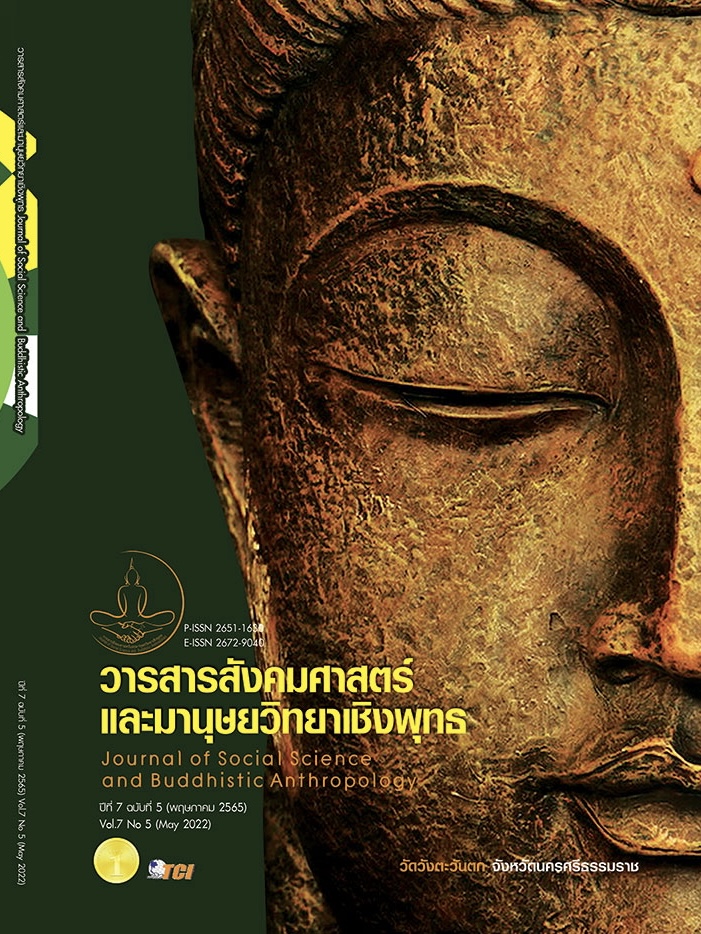MARKETING MIX AND MEDIA EXPOSED TOWARD POST-FACE COSMETIC SURGERY CONSUMER BEHAVIOR IN BANGKOK AND METROPOLITAN
Keywords:
Marketing Mix, Media Exposed, Service Psychology, Consumer Behavior, Cosmetic SurgeryAbstract
The objectives of this research article were to: 1) examine the influence of marketing mix and media exposed toward post-face cosmetic surgery on customer service psychology in Bangkok and Metropolitan and 2) examine the influence of service psychology toward post-face cosmetic surgery on consumer behavior in Bangkok and Metropolitan. The researchers conducted research by using a mixed-method. For the quantitative research, it was conducted empirical research, which was intended to be used for hypothesis testing. The study population was consumers who got facial cosmetic surgery services in Bangkok and Metropolitan. The sample sizes were 437 consumers. A quota sampling method was applied for this part of the research. A questionnaire was used as a tool for data collection. The statistic used in data analysis was structural equation model analysis. Qualitative research was intended to be used for supporting quantitative research results in the part of the discussion section. The study population of this part was persons who involved in facial cosmetic surgery. The number of samples was 5 persons. The purposive sampling method was applied for this part of the research. The semi-structured interview guide was used as a tool for data collection. The method used in data analysis was content analysis. The results of quantitative research were 1) marketing mix had a positive influence on service psychology of post-face cosmetic surgery and media exposed had a positive influence on service psychology of post-face cosmetic surgery, and 2) service psychology had a positive influence on consumer behavior toward post-face cosmetic surgery. Qualitative research results supported quantitative research results in all issues. This is consistent with the quantitative research results that are the results of testing all 3 hypotheses.
References
ทินกร โพธิ์สีตา. (2563). การรับรู้การสื่อสาร การส่งเสริมการขาย ผ่านระบบออนไลน์ร้านสะดวกซื้อของผู้บริโภคในกรุงเทพมหานคร. วารสารสุทธิปริทัศน์, 34(110), 67-76.
ไทยรัฐ ออนไลน์. (2564). “โลกแห่งความงาม” เปลี่ยนไป? เจาะตลาด มองเทรนด์ ภายใต้วิกฤติ โควิด. เรียกใช้เมื่อ 19 ตุลาคม 2564 จาก https://www.thairath.co.th/scoop /theissue /2114796
นพดล พันธุ์พานิช และสุภามาศ สนิทประชากร. (2562). รูปแบบส่วนประสมทางการตลาดและพฤติกรรมของผู้บริโภคต่อประสิทธิผลทางการตลาด การซื้ออาหารสดผ่านทางออนไลน์ผู้บริโภคในกรุงเทพมหานครและปริมณฑล. วารสารวิทยาลัยพาณิชยศาสตร์บูรพาปริทัศน์, 14(2), 31-49.
แนวหน้า. (2564). ตลาดศัลยกรรมความงามไทย ติดอันดับ 8 ของโลก ‘หมอบอย’ ชี้ศัลยแพทย์ไทยฝีมือเชี่ยวชาญระดับสากล. เรียกใช้เมื่อ 17 ตุลาคม 2564 จาก https://www.naew na.com/lady /470752
ปาริชาติ ทาโน และคณะ. (2561). การตรวจสอบความตรงเชิงโครงสร้างของแบบวัดอภิปัญญาของนักศึกษาพยาบาลด้วยการวิเคราะห์องค์ประกอบเชิงยืนยัน. วารสารเกื้อการุณย์, 25(2), 7-20.
รวีวรรณ โปรยรุ่งโรจน์. (2551). จิตวิทยาการบริการ. กรุงเทพมหานคร: โอเดียนสโตร์.
สุรภา ชิตไธสง และตรีเนตร ตันตระกูล. (2563). กลยุทธ์การพัฒนาการตลาดและความสำเร็จของผู้ประกอบการธุรกิจอินทผลัมในเขตภาคกลางของประเทศไทย. วารสาร
วิชาการ สถาบันเทคโนโลยีแห่งสุวรรณภูมิ, 6(1), 344-356.
Arifin, Z. et al. (2020). The Influence of Marketing Mix on Brand Image, Motivation and Students Decision to Choose Graduate Studies of IPB University. Journal of Consumer Sciences, 5(2), 139-156.
Best, J. W. (1981). Research in education. New Jersey: Prentice Hall.
Cochran, W. G. (1977). Sampling techniques (3rd ed.). USA: John Wiley & Sons.
Creswell, J. W. & Creswell, J. D. (2018). Research design: Qualitative, quantitative, and mixed methods approaches (5th ed.). Los Angeles: Sage.
Grand View Research. (2019). Market Analysis Report. Industry Insights. Retrieved June 17, 2020, from https://www.grandviewresearch.com/industry-analysis/general-surgery-devices-market
Hair, J. F. et al. (2019). Multivariate data analysis (8th ed.). India: Cengage.
Keuning-Plantinga, A. et al. (2021). Validation and psychometric evaluation of the Dutch person-centred care of older people with cognitive impairment in acute care (POPAC) scale. BMC health services research, 21(1), 1-10.
Khoa, B. T. & Khanh, T. (2020). The impact of electronic word-of-mouth on admission intention to private university. Test Engineering and
Management, 83 (May -June 2020), 14956-14970.
Komthong, S. et al. (2020). The impact of service quality and patient satisfaction on electronic word-of-mouth in cosmetic surgery patients in Thailand. Public Health Policy and Laws Journal, 6(2), 399-408.
Kotler, P. et al. (2014). Marketing management (14 ed.). Essex: Pearson Education.
Kuwashima, Y. (2019). The scope of motivation studies for (e) word-of-mouth. Annals of Business Administrative Science, 18(5), 183-194.
Lee, H. & Hwang, S.-J. (2020). Consumers' acceptance and diffusion of word-of-mouth in social brand community: the moderating effect of self-monitoring. Journal of Fashion Marketing and Management: An International Journal, 25(1), 1-3.
Marketee. (2019). Thai beauty clinic still beautiful, just need to adjust. Retrieved June 16, 2020, from https://marketeeronline.co/archives/67870
MThai - Women. (2018). 10 skillful Thai cosmetic surgery clinics, Don't have to fly to Korea. Retrieved October 10, 2020, from https://women.mthai.com/beauty /353325.html
Ploom, K. et al. (2020). The effect of culture on the perception of product packaging: A multimethod cross-cultural study. Journal of International Consumer Marketing, 32(3), 163-177.
Shetty, D. & Bhat, S. (2019). Recognition of oral and maxillofacial surgeons by dental professionals and their perceptions regarding cosmetic facial surgery-A questionnaire-based study. Journal of Oral and Maxillofacial Surgery, 77(12), 2556.e1-2556.e7.
Song, W. et al. (2020). Will buying follow others ease their threat of death? An analysis of consumer data during the period of COVID-19 in China. International Journal of Environmental Research and Public Health, 17(9), 1-15.
Downloads
Published
How to Cite
Issue
Section
License
Copyright (c) 2022 Journal of Social Science and Buddhistic Anthropology

This work is licensed under a Creative Commons Attribution-NonCommercial-NoDerivatives 4.0 International License.








